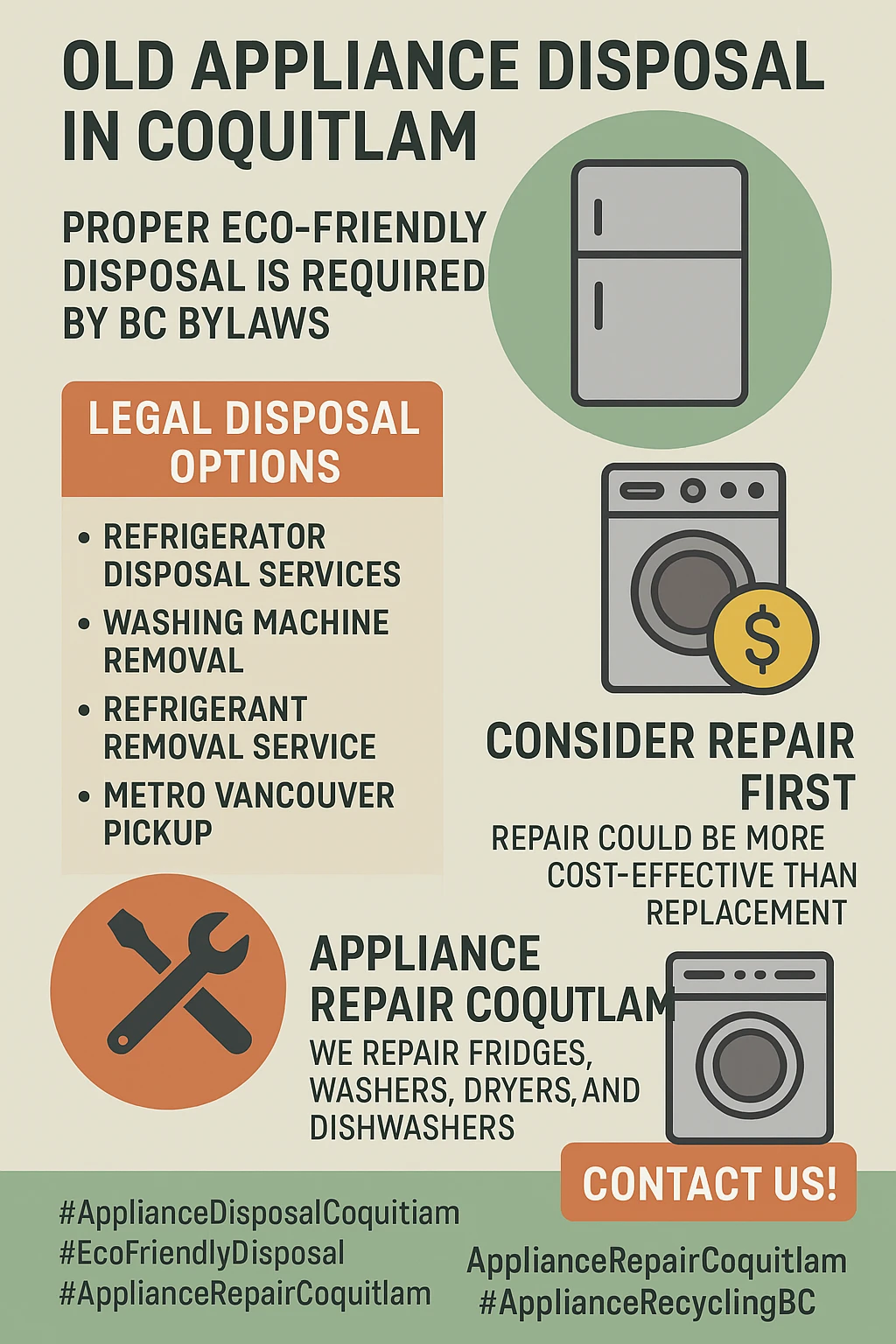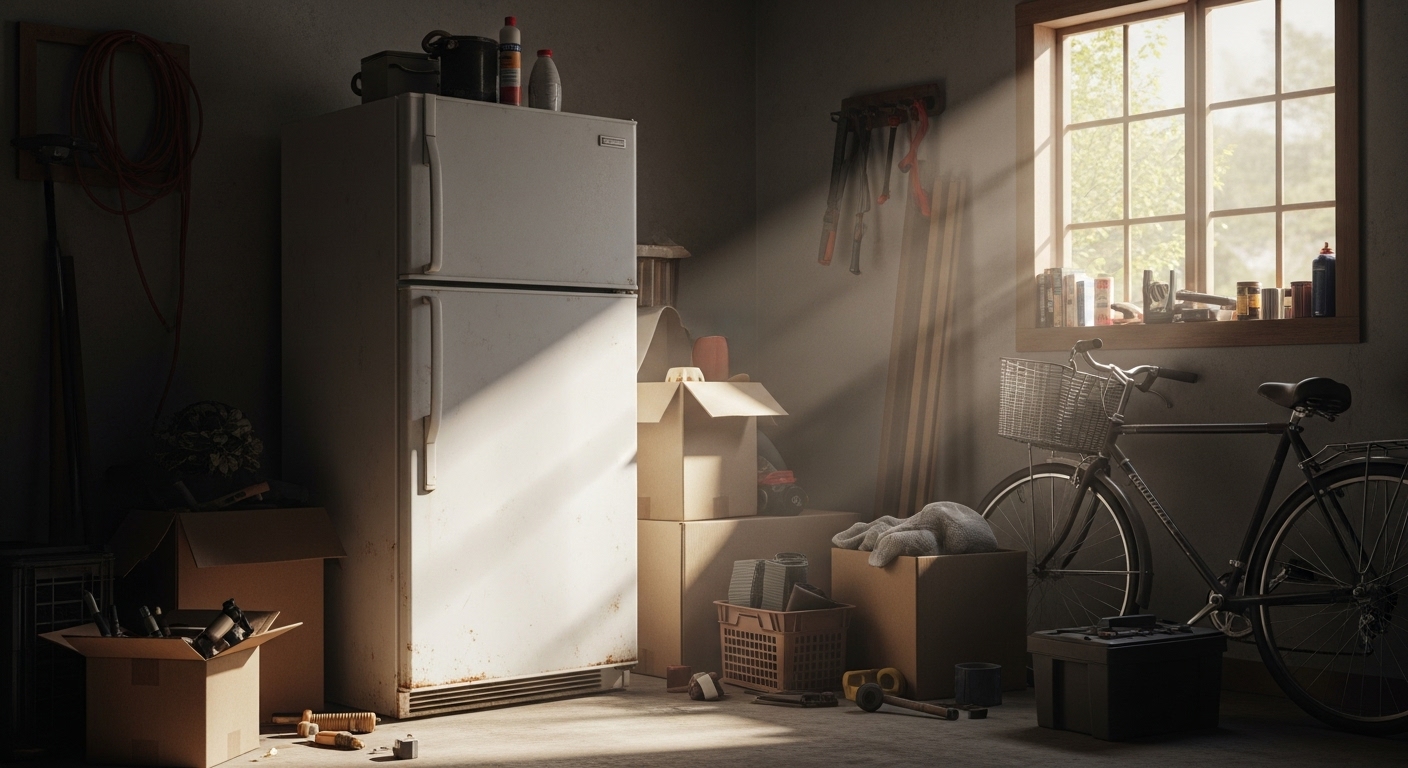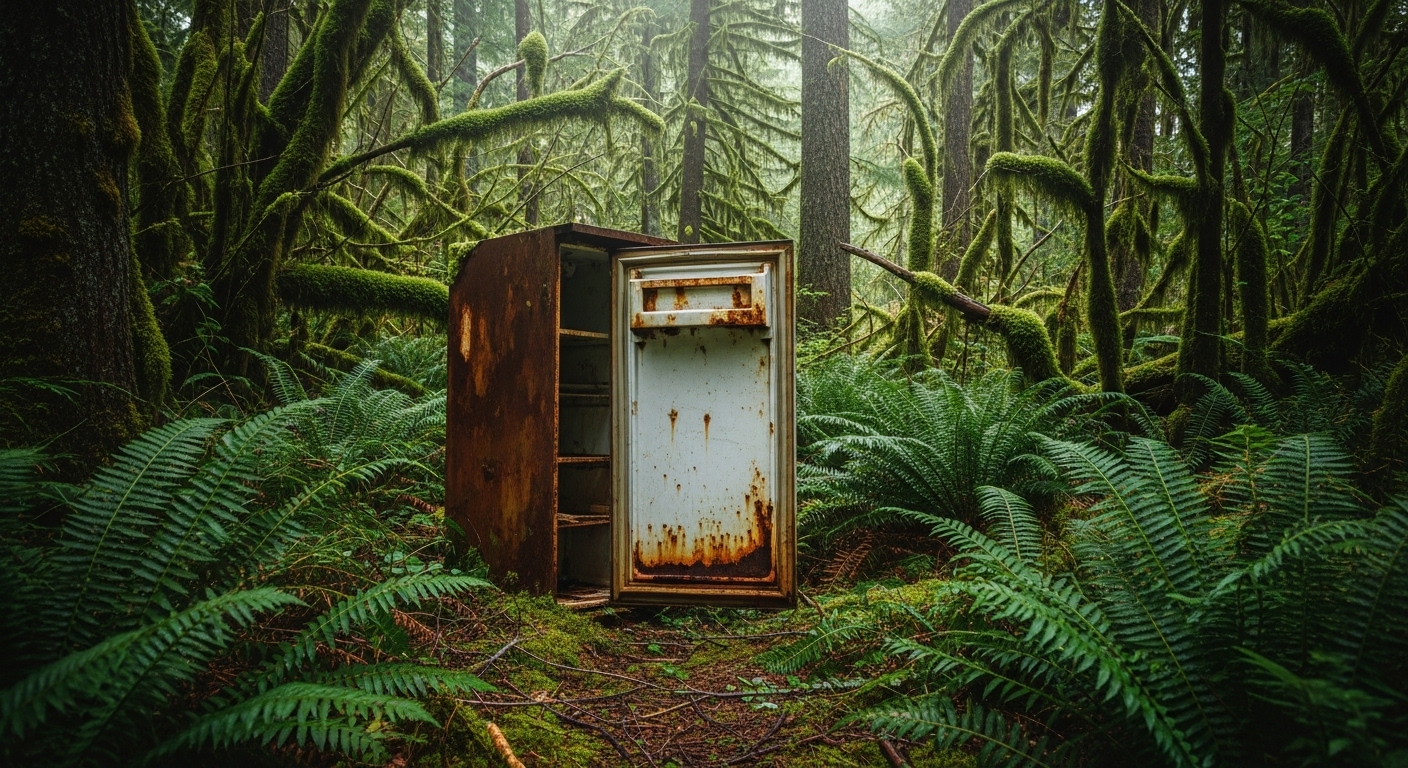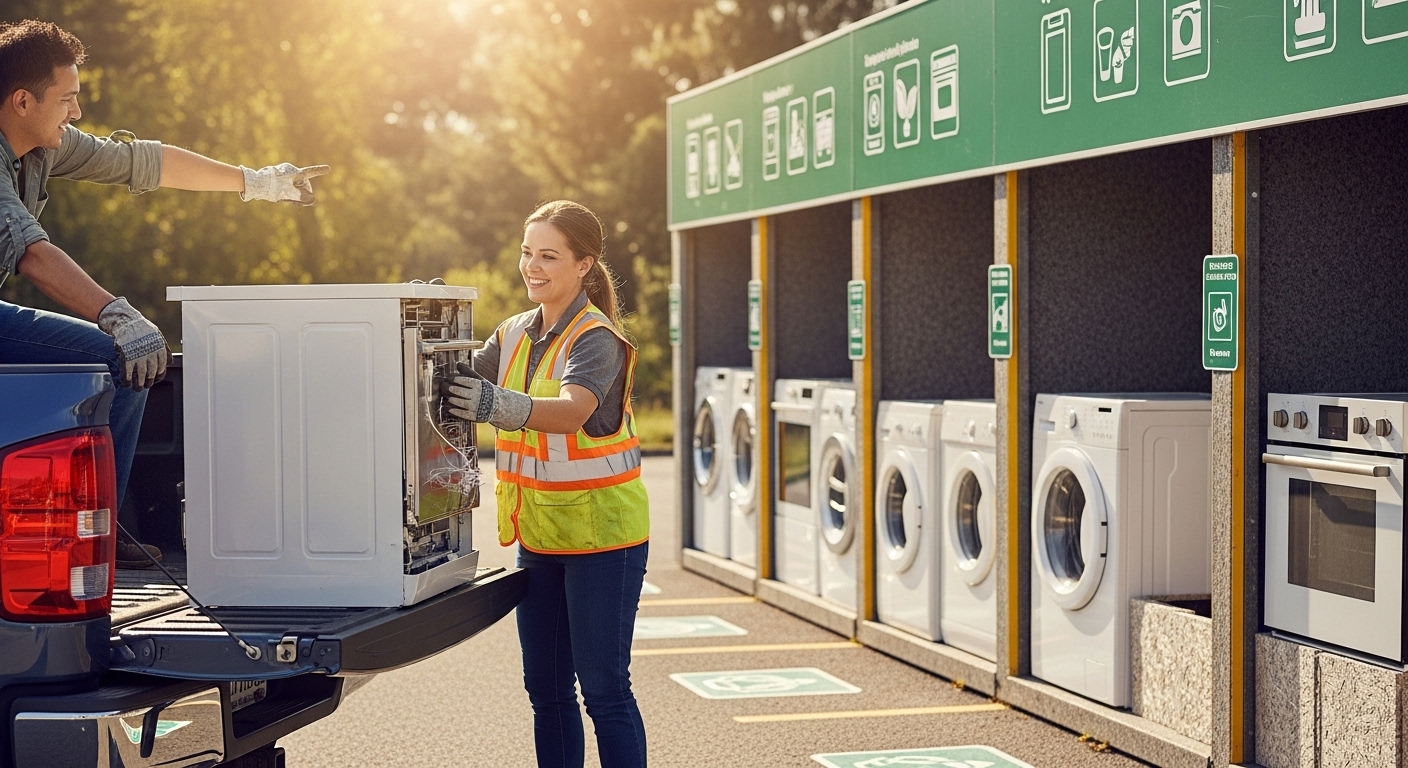Staring at that old dishwasher taking up precious garage space, wondering if you can just toss it with the regular trash? Think again – appliance disposal in Coquitlam comes with specific legal requirements and environmental responsibilities that could save you from hefty fines while protecting our beautiful BC environment. Picture this: you’re finally upgrading that ancient refrigerator that’s been humming like a freight train for the past two years. You’ve got your shiny new energy-efficient model being delivered next week, but now you’re stuck with a 200-pound metal beast that definitely won’t fit in your recycling bin. Sound familiar? If you’re a homeowner in Coquitlam, you’ve probably faced this exact dilemma – and you’re definitely not alone in wondering what the heck you’re supposed to do with old appliances. The reality is that appliance disposal isn’t as simple as dragging your old washer to the curb and hoping for the best. Between municipal bylaws, environmental regulations, and safety concerns, there’s actually a whole science to getting rid of appliances properly. But here’s the good news: Coquitlam residents have access to some pretty amazing disposal options that won’t break the bank or require a engineering degree to figure out. From free recycling programs to convenient pickup services, there are legitimate ways to ditch those old appliances without ending up on the wrong side of the law or harming the environment.
Key Outtakes:
- Never put appliances with hazardous materials like refrigerants in curbside collection – it’s illegal and dangerous
- Coquitlam residents get up to 4 free large item pickups per year through municipal services
- Major Appliance Recycling Roundtable (MARR) offers completely free appliance disposal at over 200 BC locations
- Improper appliance disposal can result in fines ranging from $100 to $1,000,000 depending on the violation
- Working appliances can often be donated for tax receipts instead of being recycled

Understanding Coquitlam’s Appliance Disposal Laws and Regulations
 Let me tell you about my neighbor Sarah, who thought she was being helpful by putting her broken dishwasher out with the regular garbage. Within hours, she had a bright orange notice slapped on her door and a not-so-friendly phone call from the city. Turns out, Coquitlam takes appliance disposal pretty seriously, and for good reason. The city has established clear guidelines that prohibit hazardous items – including most appliances – from being placed in curbside collection carts and containers. According to the city’s waste management protocols, items like motor oil, batteries, and appliances containing refrigerants can cause fires or explosions, putting waste collection workers at serious risk. These materials can also damage collection trucks and aren’t allowed at regular landfills. It’s not just about following rules – it’s about protecting people and equipment from legitimate safety hazards. The legal framework gets more complex when you zoom out to provincial regulations. British Columbia operates under an Extended Producer Responsibility (EPR) system, which basically means that the companies making and selling appliances are responsible for handling them at the end of their life cycle. This creates a network of free disposal options funded by fees collected when you buy new appliances. Think of it as a disposal deposit that’s already been paid – you just need to know how to access the services. But here’s where things get real: the penalties for improper appliance disposal aren’t just slap-on-the-wrist fines. We’re talking about potential penalties ranging from $100 for basic improper disposal up to $1,000,000 and even imprisonment for violations involving harmful chemicals like CFCs or HCFCs found in refrigerators and air conditioners. Now, before you panic, these extreme penalties are typically reserved for commercial dumping operations or people who repeatedly ignore available disposal options. Regular homeowners acting in good faith have access to plenty of legitimate disposal channels. The key thing to understand is that Coquitlam’s approach emphasizes providing accessible alternatives rather than just punitive enforcement. The city wants residents to comply with disposal regulations, so they’ve worked to make proper disposal more convenient than trying to skirt the rules. This philosophy shows up in everything from the free large item pickup program to the comprehensive recycling depot network available to residents. What makes this especially important is that appliances aren’t just regular household junk – they contain specialized components that require specific handling procedures. Refrigerators have refrigerants that can damage the ozone layer, older appliances may contain mercury switches, and many units have valuable metals that can be recovered through proper recycling. The regulations reflect these material complexities and ensure that appliances get routed to facilities equipped to handle them appropriately.
Let me tell you about my neighbor Sarah, who thought she was being helpful by putting her broken dishwasher out with the regular garbage. Within hours, she had a bright orange notice slapped on her door and a not-so-friendly phone call from the city. Turns out, Coquitlam takes appliance disposal pretty seriously, and for good reason. The city has established clear guidelines that prohibit hazardous items – including most appliances – from being placed in curbside collection carts and containers. According to the city’s waste management protocols, items like motor oil, batteries, and appliances containing refrigerants can cause fires or explosions, putting waste collection workers at serious risk. These materials can also damage collection trucks and aren’t allowed at regular landfills. It’s not just about following rules – it’s about protecting people and equipment from legitimate safety hazards. The legal framework gets more complex when you zoom out to provincial regulations. British Columbia operates under an Extended Producer Responsibility (EPR) system, which basically means that the companies making and selling appliances are responsible for handling them at the end of their life cycle. This creates a network of free disposal options funded by fees collected when you buy new appliances. Think of it as a disposal deposit that’s already been paid – you just need to know how to access the services. But here’s where things get real: the penalties for improper appliance disposal aren’t just slap-on-the-wrist fines. We’re talking about potential penalties ranging from $100 for basic improper disposal up to $1,000,000 and even imprisonment for violations involving harmful chemicals like CFCs or HCFCs found in refrigerators and air conditioners. Now, before you panic, these extreme penalties are typically reserved for commercial dumping operations or people who repeatedly ignore available disposal options. Regular homeowners acting in good faith have access to plenty of legitimate disposal channels. The key thing to understand is that Coquitlam’s approach emphasizes providing accessible alternatives rather than just punitive enforcement. The city wants residents to comply with disposal regulations, so they’ve worked to make proper disposal more convenient than trying to skirt the rules. This philosophy shows up in everything from the free large item pickup program to the comprehensive recycling depot network available to residents. What makes this especially important is that appliances aren’t just regular household junk – they contain specialized components that require specific handling procedures. Refrigerators have refrigerants that can damage the ozone layer, older appliances may contain mercury switches, and many units have valuable metals that can be recovered through proper recycling. The regulations reflect these material complexities and ensure that appliances get routed to facilities equipped to handle them appropriately.
Environmental Hazards Hidden in Your Old Appliances
 Now that we’ve covered the legal landscape, let’s talk about why these regulations exist in the first place. I used to think appliances were just big chunks of metal and plastic, but after researching this topic, I realized they’re basically environmental time bombs if not disposed of properly. The hazards lurking in your old appliances go way beyond what most people imagine. Take refrigerators and freezers, for example. These innocent-looking kitchen staples contain refrigerants like chlorofluorocarbons (CFCs) and hydrochlorofluorocarbons (HCFCs) that are serious ozone-depleting substances. When these chemicals escape into the atmosphere, they participate in chemical reactions that destroy ozone molecules for decades. We’re talking about individual CFC molecules that can destroy multiple ozone molecules through catalytic processes that continue for 20 to 100+ years after emission. The global warming potential of these substances is absolutely staggering – CFCs have warming potentials between 4,750 and 10,900 times that of carbon dioxide over a 100-year period. But refrigerants are just the beginning. Older appliances frequently contain heavy metals like mercury, lead, and cadmium that leach into soil and groundwater when appliances decompose in landfills. Mercury found in appliance switches and relays bioaccumulates through aquatic food chains, eventually reaching human populations through fish consumption. This stuff causes neurological damage, particularly in developing fetuses and young children. It’s not some distant environmental concern – it’s a direct threat to community health. Then there are the polychlorinated biphenyls (PCBs) found in contaminated oils within compressors. These persistent organic pollutants resist environmental degradation and accumulate in animal tissues, eventually reaching human food supplies and causing reproductive, immune system, and developmental effects. The polyurethane foam insulation in refrigerators contains blowing agents that, while no longer CFCs or HCFCs in most modern appliances, still represent a significant volume of landfill waste with their own environmental considerations. The physical hazards extend beyond chemical contamination to create immediate safety risks, especially for kids and pets. I’ve read some tragic stories about children getting trapped in discarded refrigerators with intact door seals – it’s a real asphyxiation hazard that happens more often than you’d think. Large appliances left in public spaces also create tripping hazards, attract vermin, and deteriorate into rusty metal structures with sharp edges that can cause serious injuries. Here’s something that really opened my eyes: when appliances are improperly disposed of instead of recycled, we’re essentially burying valuable materials that could be recovered and reused. Appliances contain substantial quantities of copper, aluminum, stainless steel, and other metals that, when recovered through proper recycling, reduce the need for energy-intensive mining of virgin ore. The copper tubing in refrigerator compressors, aluminum components in air conditioning units, and stainless steel drums in washing machines represent valuable secondary material sources. When we landfill these appliances, we’re wasting the energy embodied in their extraction and processing while simultaneously creating environmental contamination that will cost money to clean up later.
Now that we’ve covered the legal landscape, let’s talk about why these regulations exist in the first place. I used to think appliances were just big chunks of metal and plastic, but after researching this topic, I realized they’re basically environmental time bombs if not disposed of properly. The hazards lurking in your old appliances go way beyond what most people imagine. Take refrigerators and freezers, for example. These innocent-looking kitchen staples contain refrigerants like chlorofluorocarbons (CFCs) and hydrochlorofluorocarbons (HCFCs) that are serious ozone-depleting substances. When these chemicals escape into the atmosphere, they participate in chemical reactions that destroy ozone molecules for decades. We’re talking about individual CFC molecules that can destroy multiple ozone molecules through catalytic processes that continue for 20 to 100+ years after emission. The global warming potential of these substances is absolutely staggering – CFCs have warming potentials between 4,750 and 10,900 times that of carbon dioxide over a 100-year period. But refrigerants are just the beginning. Older appliances frequently contain heavy metals like mercury, lead, and cadmium that leach into soil and groundwater when appliances decompose in landfills. Mercury found in appliance switches and relays bioaccumulates through aquatic food chains, eventually reaching human populations through fish consumption. This stuff causes neurological damage, particularly in developing fetuses and young children. It’s not some distant environmental concern – it’s a direct threat to community health. Then there are the polychlorinated biphenyls (PCBs) found in contaminated oils within compressors. These persistent organic pollutants resist environmental degradation and accumulate in animal tissues, eventually reaching human food supplies and causing reproductive, immune system, and developmental effects. The polyurethane foam insulation in refrigerators contains blowing agents that, while no longer CFCs or HCFCs in most modern appliances, still represent a significant volume of landfill waste with their own environmental considerations. The physical hazards extend beyond chemical contamination to create immediate safety risks, especially for kids and pets. I’ve read some tragic stories about children getting trapped in discarded refrigerators with intact door seals – it’s a real asphyxiation hazard that happens more often than you’d think. Large appliances left in public spaces also create tripping hazards, attract vermin, and deteriorate into rusty metal structures with sharp edges that can cause serious injuries. Here’s something that really opened my eyes: when appliances are improperly disposed of instead of recycled, we’re essentially burying valuable materials that could be recovered and reused. Appliances contain substantial quantities of copper, aluminum, stainless steel, and other metals that, when recovered through proper recycling, reduce the need for energy-intensive mining of virgin ore. The copper tubing in refrigerator compressors, aluminum components in air conditioning units, and stainless steel drums in washing machines represent valuable secondary material sources. When we landfill these appliances, we’re wasting the energy embodied in their extraction and processing while simultaneously creating environmental contamination that will cost money to clean up later.
Free and Low-Cost Disposal Options Available to Coquitlam Residents
 After learning about all these potential hazards, you might be wondering how expensive it’s going to be to dispose of appliances properly. Here’s the surprising good news: Coquitlam residents have access to multiple free disposal options, plus some reasonably priced professional services that make proper disposal more convenient than trying to dump appliances illegally. The Major Appliance Recycling Roundtable (MARR) operates the gold standard of free appliance disposal in BC. They’ve got over 200 collection sites throughout the province, including several locations easily accessible to Coquitlam residents. These MARR-affiliated facilities accept the full range of major household appliances – refrigerators, freezers, air conditioners, washing machines, dryers, dishwashers, ovens, and range
After learning about all these potential hazards, you might be wondering how expensive it’s going to be to dispose of appliances properly. Here’s the surprising good news: Coquitlam residents have access to multiple free disposal options, plus some reasonably priced professional services that make proper disposal more convenient than trying to dump appliances illegally. The Major Appliance Recycling Roundtable (MARR) operates the gold standard of free appliance disposal in BC. They’ve got over 200 collection sites throughout the province, including several locations easily accessible to Coquitlam residents. These MARR-affiliated facilities accept the full range of major household appliances – refrigerators, freezers, air conditioners, washing machines, dryers, dishwashers, ovens, and range